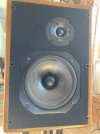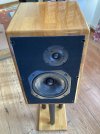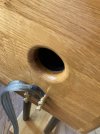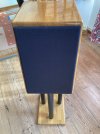Remember this one?
 3a-art-et-acoustique-appliquee.fr
I bought them in 1990.
3a-art-et-acoustique-appliquee.fr
I bought them in 1990.
They used to be from France, their successors are still built in Canada:
 reference3a.com
reference3a.com
Anyway, because the cabinet used to scratch easily and also vibrated, I decided to glue the whole box
-with it's enclosure-into a new enclosure made of glued timber - hope this is the correct word.
This must have been about 15 years ago.
I remember "painting" alone took 6 weeks as it was not paint
but a special wood oil that hardens like varnish - but takes 2 days to do so for each layer.
I love the sound - warm, detailed - but ASR shows us that this does not mean fidelity at all.
And the sound must have changed because of the mod: The front face became bigger,
as the glued timber adds 40mm on each side. The front itself became 5mm thicker
as I used veneer and felt. The bass port became 40mm longer.
And there is an integrated stand.
Any ideas how that theoretically colorizes the sound?
Best, Herbert
3A - Art & Acoustique Appliquée • Catalogue
Site consacré aux enceintes acoustiques du fabricant français 3A - Art & Acoustique Appliquée.
 3a-art-et-acoustique-appliquee.fr
3a-art-et-acoustique-appliquee.fr
They used to be from France, their successors are still built in Canada:
REFERENCE 3A
 reference3a.com
reference3a.com
Anyway, because the cabinet used to scratch easily and also vibrated, I decided to glue the whole box
-with it's enclosure-into a new enclosure made of glued timber - hope this is the correct word.
This must have been about 15 years ago.
I remember "painting" alone took 6 weeks as it was not paint
but a special wood oil that hardens like varnish - but takes 2 days to do so for each layer.
I love the sound - warm, detailed - but ASR shows us that this does not mean fidelity at all.
And the sound must have changed because of the mod: The front face became bigger,
as the glued timber adds 40mm on each side. The front itself became 5mm thicker
as I used veneer and felt. The bass port became 40mm longer.
And there is an integrated stand.
Any ideas how that theoretically colorizes the sound?
Best, Herbert
Attachments
Last edited:




